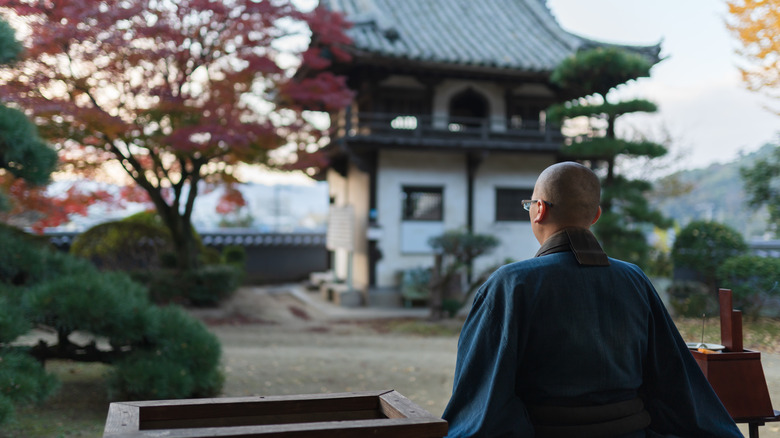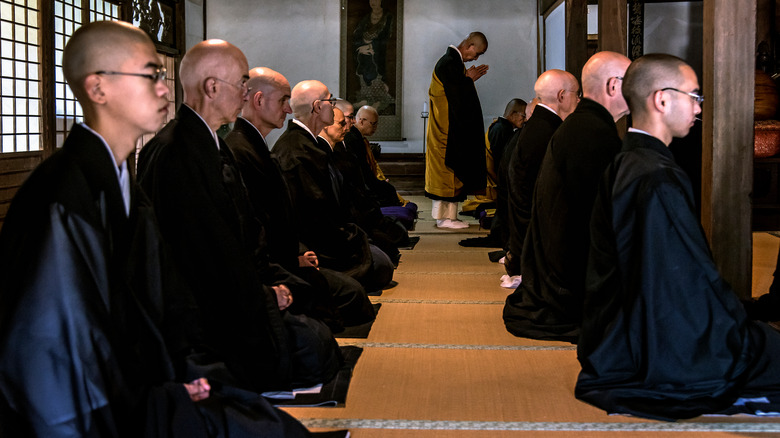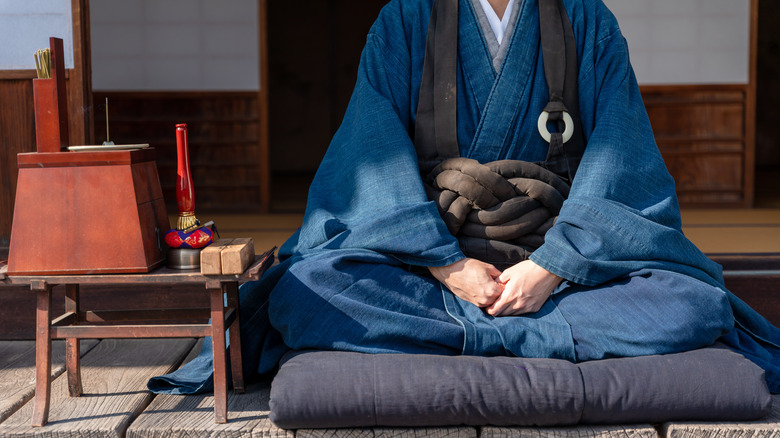Zen Buddhism: The History And Practices Explained
It's been hundreds of years since Buddhism spread from India through the entirety of East and Southeast Asia. Buddhism essentially began as a sort of rebuke of entrenched, class-based poverty and oppression in Nepal. As the stories go, Siddhattha Gautama, the original Buddha (566 – 486 BCE), was a wealthy-born guy who stepped on the path to enlightenment after leaving his palace for the first time and becoming exposed to abject poverty (as the BBC summarizes). Buddhism really is a "we're all equal in our suffering and potential virtues" outlook on life.
At each point along its exodus out of Nepal, the values and precepts of Buddhism got tweaked. In India, the Buddha became considered an incarnation of the Hindu god Vishnu. In China in the sixth century, Buddhism abutted native Taoism and Confucianism and absorbed a bit of naturalism and light-dark duality. It went from Korea in the seventh century to Japan 500 years later in the 12th century, per the BBC.
Over the centuries, core Buddhist beliefs — especially meaningful in countries with a large disparity of quality of life — intermingled with Thai, Cambodian, Vietnamese, Laotian, Indonesian, Malaysian, you name it, cultures. Some of these countries, like Indonesia, are Muslim majority (87%, per Statista), while others like Thailand are overwhelmingly Buddhist (93%, per the U.S. State Department). At present, there are numerous Buddhist schools of thought, offshoot sects, and half a billion followers worldwide, as History says. And in Japan, Buddhism took on it's very Japanese "Zen" flavor.
Be by not being
The BBC has a list of Zen principles that befuddle the mind if you were to envision them all at once. And to be honest, that's kind of the point. Precepts include (paraphrasing here), "focus on what is, not what you think is," "see what is, not what you think is," "don't think, just be," "don't philosophize, just 'get it,'" "don't be shackled by logic or words," and so on. All in all, these kinds of koans — phrases used to encapsulate abstractions and lead to enlightenment, as Big Think summarizes — are meant to perplex the mind into awareness. They're also meant to be ultimately irrelevant themselves.
It's most accurate to think of Zen Buddhism as a "way of being." You can't even accurately use words like "philosophy" or "belief system" because that implies some systematized method that precedes enlightenment and can be applied like mathematics. Just imagine (over-simplifying) sitting in the woods and being so attuned to your environment that your sense of self, your ego, your intellect and memories, everything you are, just whispers away. In that moment, you are your "true self," the self without all the accumulated garbage of sentient life. There is some incipient thing before your "self" that is, paradoxically, attainable only by vanishing.
Such Buddhist tenets, as the Association Zen Internationale explains, developed from exposure to Japan's indigenous Shinto religion. Shinto places a heavy emphasis on respect of nature and the interconnected spirit of all living things.
Transmitted from teacher to student
Zen Buddhism's history is pretty well-documented. As stated, Zen arrived in Japan from China in the 12th century (per the BBC). To its followers, though, Zen's history isn't necessarily reckoned by calendar years, but by which teacher passed on what teaching to which students.
In the sixth century, about 1,000 years after the original Buddha lived, an Indian monk named Bodhidharma carried his particular brand of Buddhism to China. Bodhidharma emphasized a simple, sitting, cross-legged meditation ("zazen" in Japanese) to achieve enlightenment, without a lot of other elaborate rituals. He also emphasized action over belief, and a kind of spontaneous "shoot-from-the-hip" enlightenment, as Lion's Roar describes it. Enlightenment would come in spits and spurts, not through a gradual process, he said.
This vein of Buddhism, called "ch'an" in China, took hold in Japan via the 13th-century monk Dogen, as Association Zen Internationale explains. At the time, other Buddhism schools had already made it to Japan, but were apparently getting a bit money-bloated. Dogen, following in the footsteps of Bodhidharma, and under the auspices of his own teacher in China, Rujing, advocated stripping Buddhism down again. Focus on the direct transmission of teacher to student, he said, in quiet, sitting, supervised meditation.
This approach jived with Japanese sensibilities so well that, at present, there are over 20,000 Zen temples across Japan, as the Association Zen Internationale also cites. Dogen also wrote an influential book called "Shobogenzo," or "The Treasure of the Eye of the True Law."
Zazen meditation throughout the day
If Zen sounds incredibly vague and ill-defined, and if words like "insight" and "truth" evoke nothing concrete to you, then Zen adherents might reply, "Free – your – mind," like Morpheus from "The Matrix" teaching Neo to jump across rooftops. The vagueness is intentional, as the thinking goes, to confound the rational, deconstructive mind. This could make Zen either incredibly frustrating to folks from an Enlightenment-founded, scientific, humanistic West, or incredibly appealing and individualistic, as Lion's Roar admits.
When it comes to how to actually "do" Zen, its practice is just as basic and austere as its principles. It really does mostly consist of regular, "zazen" meditation throughout the day. Sit with your eyes closed, possibly facing a wall (to evoke a cave-like feeling), keep your back straight, eyes slightly open and fixed on some spot slightly below your field of vision, and let a master adjust your posture or correct you. If you don't have a Zen master on hand, don't worry: most people don't. Some monks do things like hold their hands on their lap in a circle shape, thumb on thumb, palm up. If your mind wanders, your hands will also loosen their crisp circular shape, which is an indication that you're not quite as disciplined as you ought to be. Try again.
If all that sounds torturous, and you think that you'd rather binge-watch Netflix, that's also the point: self-improvement is tough. This, at least, everyone can agree on.



